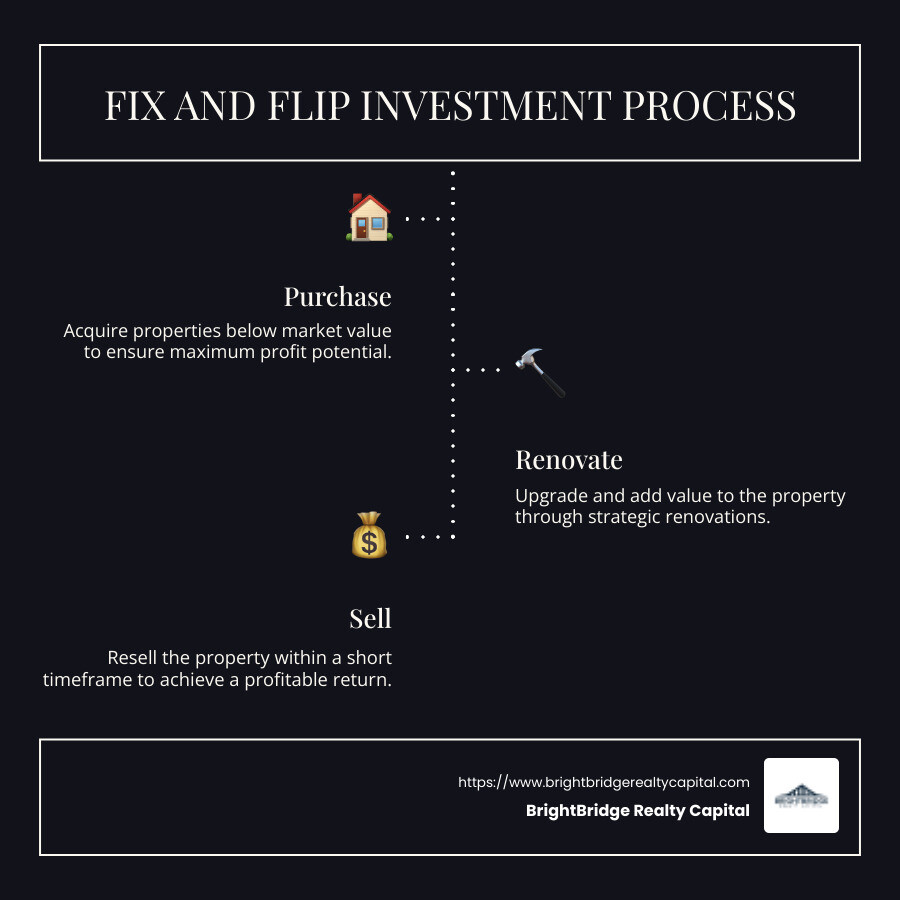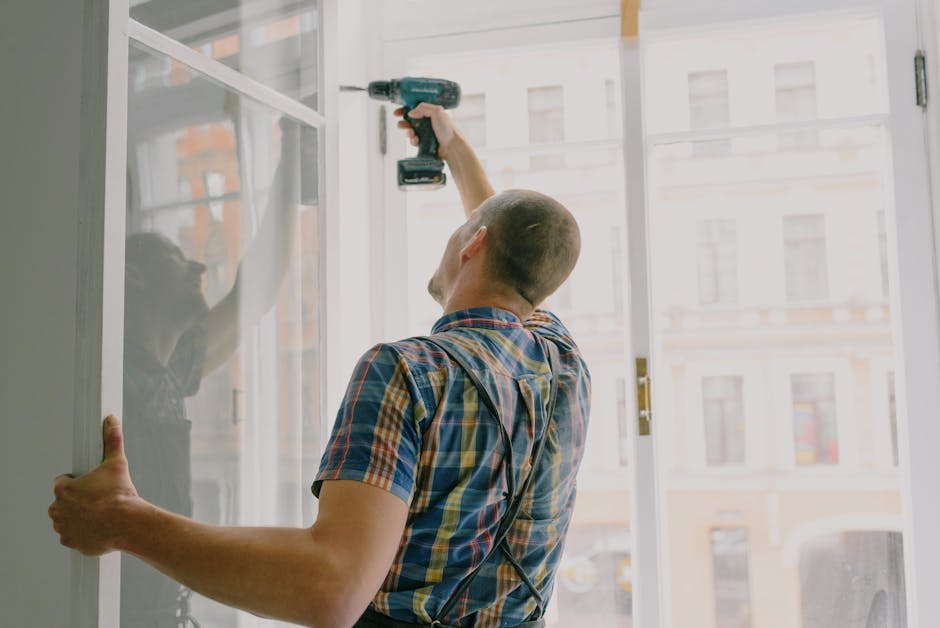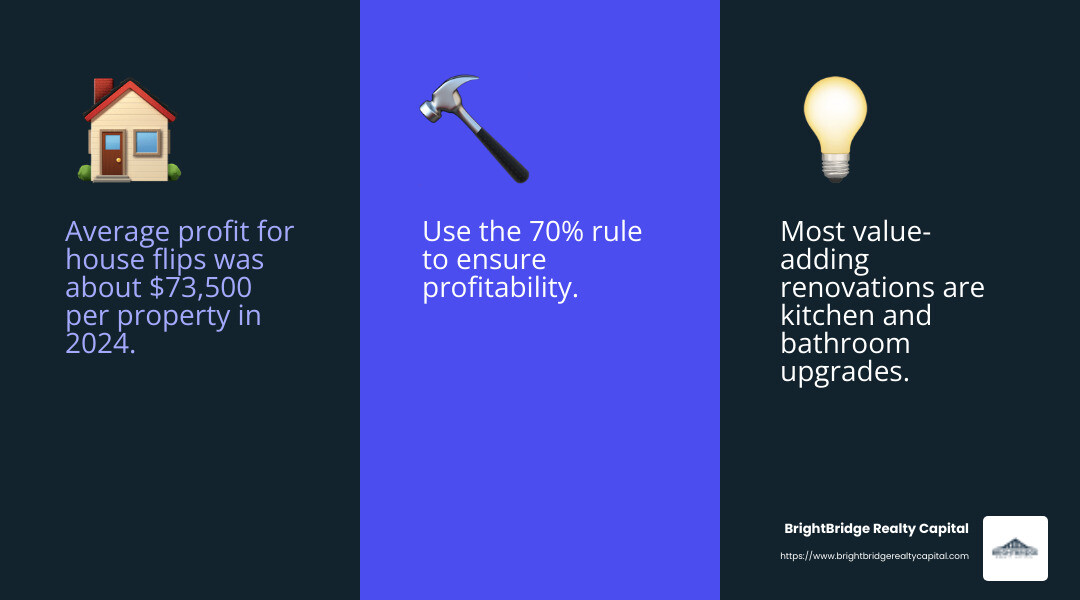From Fixer-Upper to Fortune: Mastering the Art of Fix and Flip

Fix and flip investors are changing the landscape of real estate by turning run-down properties into valuable assets. This short-term investment strategy is not just about buying and selling properties; it’s about leveraging expertise to maximize profits quickly.
For those interested in understanding how fix and flip investments work, here’s a quick summary:
- Purchase: Acquire properties below market value.
- Renovate: Improve and add value to the property.
- Sell: Resell within a short timeframe for a profit.
This strategy can offer quick returns and bypass the long-term commitments of traditional real estate investing. It also involves unique challenges, like navigating renovation costs and understanding market trends.
Why should you care? Because in a fluctuating housing market, having the knowledge and strategy to flip homes effectively can be very lucrative. Whether you're a seasoned investor or a newcomer looking to explore real estate opportunities, mastering the art of fix and flip can be your ticket to significant financial gains.

Relevant articles related to fix and flip investors:
- fix and flip real estate investing
- real estate investment process
- fix and flip joint venture agreement
Understanding Fix and Flip Investments
Fix and flip investments involve a straightforward, yet strategic process: buying, renovating, and selling properties for profit. Let's break it down:
Buying
The first step is acquiring a property at a discount. These properties are often in disrepair, abandoned, or simply outdated. The goal is to buy low, which sets the stage for potential profit.
Renovating
Next comes the renovation phase. This is where the magic happens. Investors focus on improvements that increase the property's value. This could mean anything from fixing plumbing and electrical systems to enhancing curb appeal with new windows and landscaping.
The aim is to increase the property's market value significantly. This is known as the after-repair value (ARV). For example, spending $25,000 on renovations might boost the ARV by $45,000, creating a potential profit margin of $20,000.
Selling
Finally, the property is sold. The goal is to sell quickly to maximize profits and minimize holding costs. The difference between the ARV and the total investment (purchase price plus renovation costs) is the profit.
This process can be quick, often taking around 10 months from start to finish. This short timeline is one reason why fix and flip investors find this strategy attractive.

Why It Works
Many buyers are willing to pay a premium for a move-in-ready home. They may not have the time, skills, or contacts to manage a renovation themselves. This demand for ready-to-live properties is what drives the success of fix and flip investments.
In summary, understanding fix and flip investments means recognizing the importance of buying smart, renovating effectively, and selling strategically. This approach can lead to substantial profits in a relatively short period.
The Role of Fix and Flip Investors
Fix and flip investors play a crucial role in the real estate market by changing rundown properties into desirable homes. Their strategy is all about speed and efficiency.
Quick Turnaround
The hallmark of a successful fix and flip investor is a quick turnaround. They aim to complete the purchase, renovation, and sale of a property in as little as 10 months. This swift process helps minimize holding costs, like property taxes and insurance, which can eat into profits if the project drags on.
Investment Strategy
The strategy involves more than just buying, fixing, and selling. It requires a keen eye for potential. Investors must identify properties that can be improved significantly with a reasonable budget. They focus on renovations that offer the highest return on investment, such as updating kitchens, bathrooms, and improving curb appeal.
Moreover, fix and flip investors often rely on market analysis to make informed decisions. They study neighborhood trends, comparable sales, and future developments to ensure they are investing in a property that will appeal to buyers and sell quickly.
Short-Term Ownership
Unlike traditional real estate investors who may hold properties for years, fix and flip investors are in it for the short term. Their goal is to increase the property's value quickly and sell it at a profit. This approach reduces long-term risks associated with property ownership, such as market downturns or increased maintenance costs.
Short-term ownership also allows investors to reinvest their profits into new projects, continuously growing their portfolio and expertise. This cycle of buying, renovating, and selling is what keeps the fix and flip market dynamic and lucrative.
Fix and flip investors are the catalysts that bring new life to neglected properties, benefiting neighborhoods and providing buyers with move-in-ready homes. Their ability to steer the complexities of real estate with speed and precision is what makes them successful in this high-stakes investment strategy.
Key Steps in the Fix and Flip Process
Fix and flip investors have a clear roadmap to success: buy, renovate, and sell. Each step is crucial to maximizing profits and minimizing risks.
Property Acquisition
The journey begins with acquiring the right property. This step is all about finding a hidden gem—a property that others might overlook but has great potential. Investors often use the "70% rule" to guide their purchase decisions. This rule suggests never paying more than 70% of the property's after-repair value (ARV) minus renovation costs.
For example, if a house's ARV is $300,000 and it needs $50,000 in repairs, a savvy investor would aim to buy it for no more than $160,000. This formula ensures there's room for unexpected expenses and potential profit.
Renovation
Once the property is secured, the next step is renovation. This is where the magic happens. Investors focus on upgrades that add the most value. Kitchens and bathrooms are often the top priorities, as these areas can significantly boost a home's appeal and resale price.
However, renovations aren't just about aesthetics. Structural repairs, such as plumbing and electrical work, are crucial for ensuring the property is safe and up to code. The goal is to create a home that's both beautiful and functional, ready to attract buyers.
Resale
After the dust settles and the renovations are complete, it's time for resale. This phase is all about marketing the property effectively to sell it quickly. A fast sale is essential to keep holding costs low, such as mortgage payments and utilities, which can erode profit margins if the property lingers on the market.
Investors often work with real estate agents who specialize in selling renovated homes. These professionals know how to highlight the property's new features and attract the right buyers.
Profit Margins
The final step is calculating profit margins. This involves subtracting the total costs (purchase price, renovation expenses, holding costs, and selling fees) from the resale price. The remaining amount is the investor's profit.

However, the real estate market can be unpredictable. Factors like interest rates and local market trends can impact both costs and the final sale price. Therefore, successful investors always keep an eye on the market and adjust their strategies accordingly.
In summary, the fix and flip process is a well-orchestrated dance of buying, renovating, and selling. Each step requires careful planning and execution to ensure a profitable outcome.
Challenges and Risks for Fix and Flip Investors
Fix and flip investors face several challenges that can impact their profits. Understanding these risks is key to navigating real estate flipping successfully.
Renovation Costs
Renovation costs are a major concern. They can quickly spiral out of control, especially if unexpected issues arise. For example, finding mold or outdated wiring can add thousands to the budget. According to a report by Attom, rising inflation has further increased renovation costs, making careful budgeting more important than ever.
Investors must plan for both expected and unexpected expenses. This includes setting aside a contingency fund to cover surprises that could otherwise eat into profits.
Market Fluctuations
The real estate market is unpredictable. Market fluctuations can affect both the resale price and the speed at which a property sells. As noted in the Attom report, the share of home flips decreased in many U.S. metro areas in Q3 2024, reflecting a tougher market environment.
Investors need to stay informed about local market trends. This knowledge helps them time their purchases and sales to maximize profit potential. Adapting quickly to market changes is essential for success.
Profit Margins
Profit margins in house flipping can be tight. The difference between the after-repair value (ARV) and the total costs determines the profit. However, increased costs and market conditions can squeeze these margins. In Q3 2024, profit margins averaged less than 30% in nearly half of surveyed metros, according to Attom.
To protect profits, investors must be meticulous in their calculations. Using tools like ROI calculators can help estimate potential returns and identify deals that meet profit goals.
Interest Rates
Interest rates are another critical factor. They affect the cost of borrowing money for both purchasing and renovating properties. High interest rates can significantly increase expenses, reducing overall profitability. As noted by Rob Barber, CEO of Attom, current interest rates are double what they were a few years ago, adding another layer of complexity for investors.
Investors should shop around for competitive loan rates and consider locking in rates when favorable. This strategic move can help manage financing costs and protect profit margins.
In conclusion, fix and flip investors must steer a landscape filled with potential pitfalls. By understanding these challenges—renovation costs, market fluctuations, profit margins, and interest rates—they can make informed decisions and increase their chances of success.
Frequently Asked Questions about Fix and Flip Investors
What is the typical timeline for a fix and flip project?
Fix and flip investors often aim for a quick turnaround to maximize profits. The average timeline for a fix and flip project is about 10 months. This includes the time from acquiring the property, completing renovations, and then selling it. However, the timeline can vary based on the extent of the renovations needed and market conditions. Efficient planning and execution are crucial to staying on schedule and ensuring profitability.
How do fix and flip investors calculate potential profits?
The potential profit for a fix and flip project is calculated by considering several key factors:
- After-Repair Value (ARV): This is the estimated market value of the property after renovations are complete. Investors use local market comps to determine this value.
- Renovation Costs: This includes all expenses related to improving the property, such as materials, labor, and any unforeseen repairs like mold removal or plumbing issues.
- Resale Price: The final selling price of the property. Ideally, this should exceed the sum of the purchase price and renovation costs to ensure a profit.
To calculate potential profit, investors subtract the total costs (purchase price + renovation costs) from the ARV. This difference represents the expected profit.
What are common financing options for fix and flip projects?
Financing is a crucial aspect of fix and flip projects. Investors have several options to fund their ventures:
- Fix-and-Flip Loans: These are short-term loans specifically designed for house flipping. They offer high leverage, allowing investors to finance up to 95% of the purchase price and 100% of renovation costs. BrightBridge Realty Capital provides such loans with competitive rates and no prepayment penalties, making them an attractive option for investors.
- Traditional Loans: While not as common due to longer approval times and stricter requirements, some investors use traditional mortgages or home equity lines of credit.
- Private Money Lenders: These lenders offer more flexible terms and faster access to funds compared to traditional banks. However, they may come with higher interest rates.
Choosing the right financing option is vital for managing costs and maximizing returns. Investors should explore all available options to find the best fit for their project needs.
Conclusion
In fix and flip investors, having the right partner can make all the difference. That's where BrightBridge Realty Capital comes in. We specialize in providing customized financing solutions that cater to the unique needs of each investor. Whether you're just starting or are a seasoned flipper, our goal is to help you succeed in your real estate ventures.
One of our standout features is our ability to offer fast closings. We understand that in the world of real estate, timing is everything. Our streamlined process allows you to close deals often within a week, ensuring you can seize opportunities the moment they arise. This quick turnaround is crucial for maximizing your investment potential and staying ahead of the competition.
Moreover, our direct lending model cuts out intermediaries, allowing us to offer competitive rates that are hard to beat. By dealing directly with us, you benefit from a seamless process that saves you time and money. Our team of experts is dedicated to guiding you through every step, from application to final payoff, ensuring a smooth and efficient experience.
If you're ready to take your fix and flip projects to the next level, consider partnering with BrightBridge Realty Capital. Visit our website to learn more about how we can support your investment journey with custom financing solutions and expert guidance. Let us help you turn fixer-uppers into fortunes.


